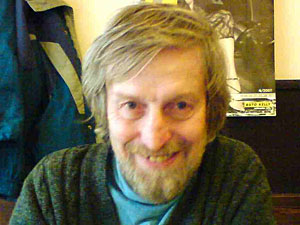Mario Matouš: 1947–2013
By Emil Vlasák
Mario Matouš was born in Mladá Boleslav (55 km north-east of
Prague) on June 16th 1947 into an intellectual family – both his parents
were language teachers. The three-year-old boy’s first memories are
connected with the arrest of his mother, who was imprisoned by the Communist
regime for about two years for purely political reasons. As was the practice
at that time, the whole family was persecuted. The father was obliged to
take a third-rate manual job and the children spent some time in nurseries.
Mario declined to participate in “Pioneer” (the mass communist
youth organization) and instead worked actively in the Roman Catholic Church.
The communists did not forgive such things, and a well-read boy with an
excellent academic record obtained permission only to be trained as a fitter.
However, Mario, like most chess players, was not manually skilled and thus
had a lifetime problem in finding suitable employment.
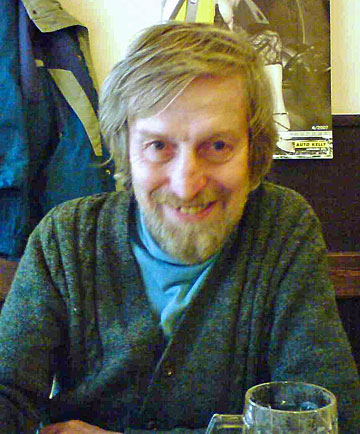
Fortunately, Mario had learned chess at the age of nine, and this opened
up better prospects. After national service in 1968 he gradually became
a master class player. Thanks to his chess contacts he also got a good job.
In 1971 Mario won the Central Bohemian championship and as a result played
in the Czechoslovak semi-final. Despite the problems with the regime, these
were the best years of Mario’s life. He liked chess friends around,
jokes and a lot of beer.
Matouš published his first endgame study in 1968, and quickly gained
an international reputation. He always needed a lot of beer to get an inspiration.
But after getting it, he suddenly changed into an austere and hard-working
man. He didn’t sleep, drink or eat, and spent many days and nights
feverishly working out the idea. Where a normal composer would test one
or two versions, Matouš sifted dozens. There were attempts to improve
his studies, but usually Mario just laughed. He had almost everything on
his “playground” and knew exactly why he went his way.
The results were excellent – precise constructions in a classical
and economical style. He published almost 300 studies and won more then
160 honours (20 commendations, 50 honorable mentions and 80 prizes, 20 being
first prizes). He was many times Czechoslovak and Czech champion, and he
was a Czech Master of Sport and a FIDE Master.
Matouš spent most of his life in Prague with his girlfriend Hana.
He hated the communist regime, but ironically he started to get worse after
its fall. He again had problems in finding a job and after several attempts
found a haven as a night security guard. Even his tournament results in
endgame studies dropped off a little. Matouš became a little hackneyed,
and he received more honourable mentions than prizes. However his highest
compositional level was maintained until about 2009. Then he became completely
overwhelmed by creative depression and Mario stopped publishing altogether.
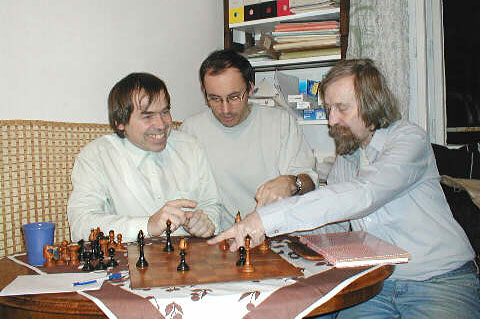
Emil Vlasák, Jaroslav Polášek,
Mario Matouš at the EG study composers meeting in 2002
In February 2008 I met Mario in Prague pub “Na Tremošné”
to talk about our forthcoming book. Although I entered the pub before eleven
in the morning, it was already too late to catch the Master sober and again
we did not make progress. As usual, the talk turned to Mario's monologue
about his inward problems. His idol Bobby Fischer had died a month before.
“To die at the age of 64 is an ideal chess player’s end,”
said Mario. “But Fischer got there first, and if I did so as well
it would not be original.” Such a pessimistic mood had unfortunately
materialized in Matouš’s lifestyle; consumption accompanied by
chain smoking. The final blow was Hana’s death. Mario died on July
4th 2013 at the age of 66 years in a medical institution, almost alone and
destitute.
Source: JSB
The John and Sue Beasley WebSite, which sneak previewed the full obituary
to be published in EG194, the Oktober 2013 edition by ARVES.
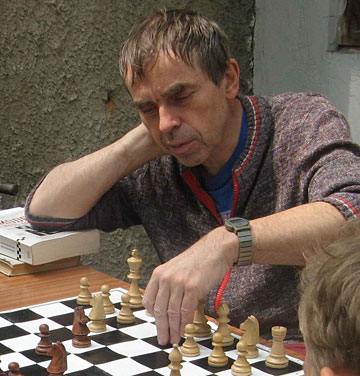
The author of the obituary, Emil Vlasák, 57, married
with two children (Tom, Susan), graduated from the CVUT, the leading Czech
Technical University in Prague, in the department of electronics and cybernetics.
He has played chess for over 20 years in the Czech OTB league, and also
won the Czechoslovakian Team Correspondence Championship in 1991. Since
1971 Emil has composed over 90 endgame studies, with 40 awards and ten prizes.
He wrote the weekly chess problem column Pruboj from 1983 to 1996 –
about 700 columns – and published around 30 study articles in Ceskoslovenský
šach and Šachová skladba, as well as 50 computer columns
in Ceskoslovenský šach. Emil has written chess software: CBTree,
CBStar, FGCRW, Diagra, CCMeet, CQLViewer. He has been running his
own web site on computer chess and studies since 1999.
A selection of studies
A rival of Matouš was the hard-working composer in the former Czechoslovakia
Michal Hlinka. Mario said about it: “The difference between Hlinka
and Matouš? Hlinka produced a hundred studies from one idea, while
Matouš from a hundred ideas produced one study.” Somewhat exaggerated,
but pretty accurate. Here's a truly remarkable early Matouš, selected
by Brian Stephenson for the magazine CHESS
(October 2013, p.14). It contains three necessary underpromotions for White
to win.
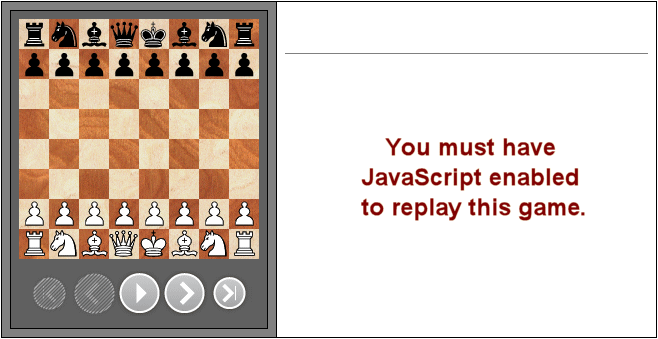
[Event "Ceskoslovensky Sach#412"] [Site "?"] [Date "1968.??.??"] [Round
"?"] [White "Matous, Mario"] [Black "White to play and win"] [Result "1-0"]
[Annotator "Stephenson,Brian"] [SetUp "1"] [FEN "6br/1P2Ppk1/1p2p3/p3P1KP/P4P2/q2p1P2/8/8
w - - 0 1"] [PlyCount "43"] [EventDate "1968.??.??"] {Black has a great
material advantage, but his rook, bishop and king are awkwardly placed.
White has two pawns on the verge of promotion and they must not be wasted.}
1. e8=N+ $1 (1. e8=Q $2 {is not forcing enough. After} Qc5 $1 { Black
has all the play.}) 1... Kh7 ({If} 1... Kf8 2. b8=Q Rxh5+ (2... -- {The
threat of} 3. Nf6+ Kg7 4. h6+ Rxh6 5. Qxg8# {wins the game quickly for
White.}) 3. Kxh5 Bh7 4. Kh6 Ke7 5. Nf6 Qxa4 6. Qc7+) 2. h6 {The mate threat
on f6 forces the black queen to e7, after which White can force its eventual
exchange, leading to a position where Black is almost completely tied
up.} Qe7+ 3. Nf6+ Qxf6+ 4. Kxf6 d2 5. b8=Q d1=Q 6. Qf8 Qg1 7. Qg7+ Qxg7+
8. hxg7 b5 $1 ({ In this position, and for the next few moves, Black must
not move his king, else he gets mated in a few moves, as this line shows}
8... Kh6 9. gxh8=Q+ Bh7 10. Qg7+ Kh5 11. Qxh7#) 9. axb5 a4 10. b6 a3 11.
b7 a2 12. b8=N $1 {White makes his second underpromotion to a knight.}
({Promotion to queen is again not forcing enough:} 12. b8=Q $2 a1=Q 13.
gxh8=Q+ Kxh8 14. Qf8 Qg1 15. Qh6+ Bh7 16. Kxf7 Qg8+ 17. Ke7 (17. Kf6 Qd8+
18. Kf7 Qd7+ 19. Kf8 Qd8+ 20. Kf7 Qd7+ { draws by repetition.}) 17...
Qg7+ (17... Qf7+ 18. Kd6 {draws.}) 18. Qxg7+ Kxg7 19. Kxe6 {and Black
can hold back the pawns and draw.}) 12... a1=Q ({The threat was} 12...
-- 13. Nd7 a1=Q 14. Nf8+ Kh6 15. gxh8=Q+ Bh7 16. Qxh7#) 13. Nd7 Qa8 ({Or}
13... Qa3 {which leads to the same.}) 14. Nf8+ Qxf8 15. gxf8=R $1 {This
third underpromotion is the only way to win.} (15. gxf8=Q $2 {is stalemate.})
15... Kh6 16. Rd8 Kh5 17. Kg7 Rh7+ 18. Kxg8 Kh6 19. Rd1 Rg7+ 20. Kf8 Rg2
21. Kxf7 Rh2 22. Kxe6 {and wins.} 1-0
Here's a late study, composed almost 40 years after the previous one. It
was selected Study of the Year 2007 at the Yurmala (Latvia) annual congress
for chess composition, and contains four double exclam moves!!

[Event "1.p Polasek-50 JT Vlasak-50 JT Ceskoslo"] [Site "?"] [Date "2007.??.??"]
[Round "?"] [White "Matous, Mario"] [Black "White to play and win"] [Result
"1-0"] [SetUp "1"] [FEN "8/q7/8/2pp4/5K2/8/2RN1B1k/8 w - - 0 1"] [PlyCount
"13"] [EventDate "2007.??.??"] 1. Nf3+ Kh1 $1 (1... Kh3 2. Ng5+ Kg2 3.
Bxc5+) 2. Bd4 $3 ({This spectacular move cannot be replaced by} 2. Bxc5
$2 Qa4+ 3. Nd4 Qxd4+ $1 4. Bxd4 {stalemate. }) 2... Qf7+ $1 ({After} 2...
Qc7+ $2 {White's material advantage decides, for example} 3. Ne5 Qc8 (3...
Qb8 4. Rb2 $1 Qf8+ 5. Kg3 Qg7+ 6. Ng4 Qc7+ 7. Be5 Qh7 8. Rd2) 4. Kg3 Qg8+
5. Ng4 Qb8+ 6. Kh3 Qb3+ 7. Rc3 Qb1 8. Nf2+ Kg1 9. Ne4+ cxd4 10. Rg3+ Kf1
11. Nd2+) ({Bad is} 2... Qb8+ 3. Be5 Qf8+ 4. Ke3 Qh6+ 5. Kf2 c4 6. Ra2
Qb6+ 7. Bd4 Qb1 8. Ra1) 3. Ke3 $3 (3. Kg3 $2 Qg6+ {costs the rook.}) 3...
cxd4+ 4. Kf2 $1 Qf4 5. Rc6 $3 {Reciprocal zugzwang, as the queen has surprisingly
no good squares.} ({Very bad is} 5. Re2 $2 Qe3+) ({Other attacking rook
moves lead to a perpetual check:} 5. Ra2 $2 Qc1 6. Kg3 (6. Ra8 Qc2+ 7.
Kg3 Qg6+ 8. Kf2 Qc2+) 6... Qc7+ 7. Kf2 Qc1) ({Or} 5. Rc8 $2 Qe3+ 6. Kg3
Qh6 7. Kf2 Qe3+ 8. Kg3 Qh6) {A pawn has to move and obstruct the important
diagonal b1-h7 in two echo lines:} 5... d3 (5... Qe3+ 6. Kg3 {Another
reciprocal zugzwang.} d3 7. Ra6 $1 Qc1 8. Ra7 $1) 6. Rc8 $1 Qh6 7. Rb8
$1 { wins.} 1-0
Here is one which is fun to check out with a chess engine, which will take
some time to figure out the only winning strategy. Humans, of course, will
take longer and most of us will have no way to find the incredible forcing
second move that provokes the long-term zugzwang that is Black's downfall.

[Event "1.hm Szachy#0645 (v)"] [Site "?"] [Date "1975.??.??"] [Round
"?"] [White "Matous, Mario"] [Black "White to play and win"] [Result "1-0"]
[SetUp "1"] [FEN "n2Bqk2/5p1p/5KP1/p7/6Q1/8/8/8 w - - 0 1"] [PlyCount
"25"] [EventDate "1975.??.??"] {It is difficult to believe, but White
actually has a forced mate here.} 1. Qc8 $1 {Threatening mate in two with
Be7+ and Qxe8#.} {Forced.} Kg8 (1... Qe6+ 2. Qxe6 fxe6 3. gxh7) (1...
Nc7 2. Be7+ Kg8 3. gxf7+) {Could anyone ever believe that White must now
play} 2. Bc7 $3 {which looks completely suicidal.} Qxc8 ( 2... Nxc7 3.
gxf7+) 3. gxf7+ Kh8 {Black is a queen and pawn up, but your engine will
now tell you: White mates in ten moves!} (3... Kf8 4. Bd6#) 4. Be5 $1
{[%cal Gf6e7,Gf6g5] Threatening 5.Ke7 or Kg5 mate.} Qc5 $1 {[%csl Rf8]
Protects against 5.f8Q# and threatens to draw with QxBe5+.} 5. Bb2 $1
{ Threatening 6.Ke6+ and mate.} (5. Ba1 $2 Nc7 6. Bb2 a4 7. Ba1 a3) 5...
Nc7 $1 6. Ba1 $1 {[#]Black is in zugzwang: any move by the queen or knight
leads to a quick mate. So only the pawn is left to move.} a4 7. Bb2 a3
8. Ba1 a2 9. Bb2 a1=Q 10. Bxa1 {and now the zugzwang is complete, Black
has no moves left.} Nd5+ 11. Ke6+ Nc3 12. Bxc3+ Qxc3 13. f8=Q# 1-0
One of the great features of Mario’s work was a continued link with
practical chess. Whenever Mario arrived on the scene, he forced players
to solve his new studies. Therefore several players sought him out, while
others for the same reason avoided him. Here is a beautiful composition,
selected by the Prague Chess Society,
which is preparing to release a book of Matouš studies.
Mario Matouš, Thèmes 64#3657, 1980
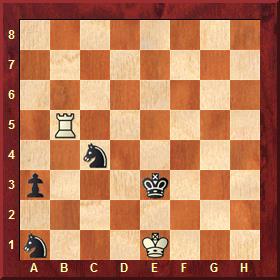
White to play and draw
Try to work out this study all by yourself. The solution will be added
to this page in about a week.
